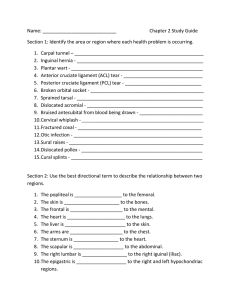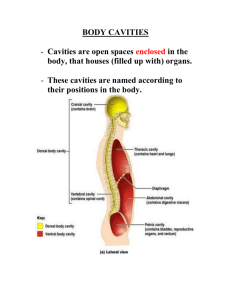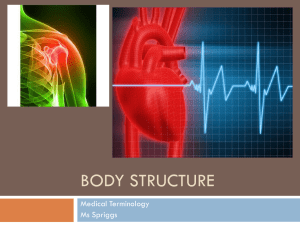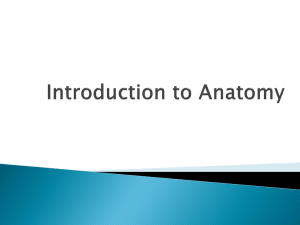THE CHALLENGE AND REALIZATION OF THE CAVITY PRODUCTION
advertisement
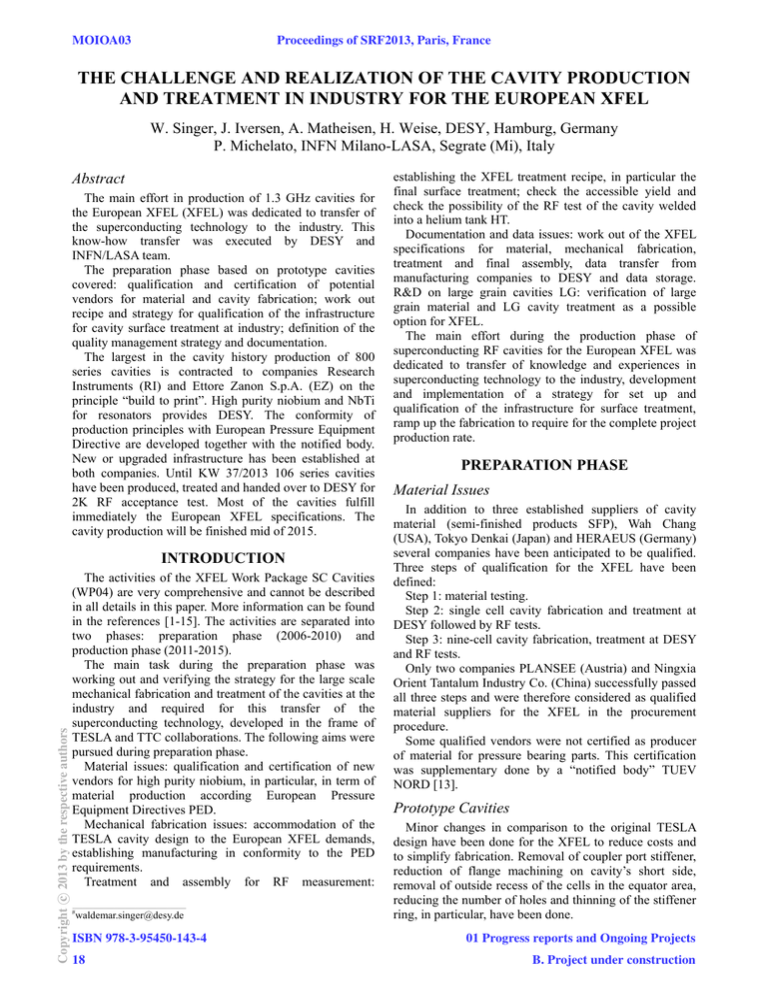
MOIOA03 Proceedings of SRF2013, Paris, France THE CHALLENGE AND REALIZATION OF THE CAVITY PRODUCTION AND TREATMENT IN INDUSTRY FOR THE EUROPEAN XFEL W. Singer, J. Iversen, A. Matheisen, H. Weise, DESY, Hamburg, Germany P. Michelato, INFN Milano-LASA, Segrate (Mi), Italy Abstract The main effort in production of 1.3 GHz cavities for the European XFEL (XFEL) was dedicated to transfer of the superconducting technology to the industry. This know-how transfer was executed by DESY and INFN/LASA team. The preparation phase based on prototype cavities covered: qualification and certification of potential vendors for material and cavity fabrication; work out recipe and strategy for qualification of the infrastructure for cavity surface treatment at industry; definition of the quality management strategy and documentation. The largest in the cavity history production of 800 series cavities is contracted to companies Research Instruments (RI) and Ettore Zanon S.p.A. (EZ) on the principle “build to print”. High purity niobium and NbTi for resonators provides DESY. The conformity of production principles with European Pressure Equipment Directive are developed together with the notified body. New or upgraded infrastructure has been established at both companies. Until KW 37/2013 106 series cavities have been produced, treated and handed over to DESY for 2K RF acceptance test. Most of the cavities fulfill immediately the European XFEL specifications. The cavity production will be finished mid of 2015. c 2013 by the respective authors Copyright ○ INTRODUCTION The activities of the XFEL Work Package SC Cavities (WP04) are very comprehensive and cannot be described in all details in this paper. More information can be found in the references [1-15]. The activities are separated into two phases: preparation phase (2006-2010) and production phase (2011-2015). The main task during the preparation phase was working out and verifying the strategy for the large scale mechanical fabrication and treatment of the cavities at the industry and required for this transfer of the superconducting technology, developed in the frame of TESLA and TTC collaborations. The following aims were pursued during preparation phase. Material issues: qualification and certification of new vendors for high purity niobium, in particular, in term of material production according European Pressure Equipment Directives PED. Mechanical fabrication issues: accommodation of the TESLA cavity design to the European XFEL demands, establishing manufacturing in conformity to the PED requirements. Treatment and assembly for RF measurement: ___________________________________________ # waldemar.singer@desy.de ISBN 978-3-95450-143-4 18 establishing the XFEL treatment recipe, in particular the final surface treatment; check the accessible yield and check the possibility of the RF test of the cavity welded into a helium tank HT. Documentation and data issues: work out of the XFEL specifications for material, mechanical fabrication, treatment and final assembly, data transfer from manufacturing companies to DESY and data storage. R&D on large grain cavities LG: verification of large grain material and LG cavity treatment as a possible option for XFEL. The main effort during the production phase of superconducting RF cavities for the European XFEL was dedicated to transfer of knowledge and experiences in superconducting technology to the industry, development and implementation of a strategy for set up and qualification of the infrastructure for surface treatment, ramp up the fabrication to require for the complete project production rate. PREPARATION PHASE Material Issues In addition to three established suppliers of cavity material (semi-finished products SFP), Wah Chang (USA), Tokyo Denkai (Japan) and HERAEUS (Germany) several companies have been anticipated to be qualified. Three steps of qualification for the XFEL have been defined: Step 1: material testing. Step 2: single cell cavity fabrication and treatment at DESY followed by RF tests. Step 3: nine-cell cavity fabrication, treatment at DESY and RF tests. Only two companies PLANSEE (Austria) and Ningxia Orient Tantalum Industry Co. (China) successfully passed all three steps and were therefore considered as qualified material suppliers for the XFEL in the procurement procedure. Some qualified vendors were not certified as producer of material for pressure bearing parts. This certification was supplementary done by a “notified body” TUEV NORD [13]. Prototype Cavities Minor changes in comparison to the original TESLA design have been done for the XFEL to reduce costs and to simplify fabrication. Removal of coupler port stiffener, reduction of flange machining on cavity’s short side, removal of outside recess of the cells in the equator area, reducing the number of holes and thinning of the stiffener ring, in particular, have been done. 01 Progress reports and Ongoing Projects B. Project under construction Proceedings of SRF2013, Paris, France 01 Progress reports and Ongoing Projects B. Project under construction additional HPR and re-test reached yield was close to 90%. Based on prototype cavities it was decided that for the European XFEL cavity production industry will carry out the mechanical fabrication, helium tanks fabrication and integration of the cavities into the helium tanks, cavity treatment according to DESY recommendations and assembly of provided by DESY High Order Mode HOM antennas, pick-up antennas, high Q fix antennas in the required clean conditions for the RF test. Vertical RF test will be done at DESY. In order to avoid the overheating of HOM couplers a pulse acceptance test with ca. 5s long pulses and off time of ca. 50s has been proposed [5]. Documentation The specifications for the XFEL cavity production define the requirements for mechanical fabrication, treatment, assembly and quality management. In addition, the specification contains in an annex to the specification the detailed practical recommendations based on DESY experiences. The required inspection data and documentations are listed. It was defined that a commercially available EDM System (Engineering Data Management) in use at DESY since several years should be used for XFEL as a central repository of all engineering information. This includes all documentation of the manufacturing process from niobium sheets to the cavity integrated in the helium tank [6]. The external manufacturers are being connected to the EDMS. Upload scripts are programmed that allow DESY to perform quality control activities and to access process documentation especially during early stages of the production process. Large Grain Cavities The manufacturing approach of slicing discs from the melted ingot and producing cavities by deep drawing and electron beam welding (large grain LG) was taken into consideration for XFEL as an option [7]. Several single cell and eleven 9-cell cavities have been produced from LG material. The tested cavities demonstrated adequacy for XFEL performance even using a simplified treatment procedure (BCP only). After the BCP treatment (removal of 100 µm surface layer inside and 20µm outside, annealing at 800°C for 2h, final BCP of 20 µm inside followed by baking at 125°C135°C for 48h.) an accelerating gradients of 25-30 MV/m in the π-mode measurement and up to 35 MV/m in the pass band measurement was achieved in a stable and reproducible manner for all eleven 9-cell LG TESLA shaped cavities. After additional EP consisting of Main EP of about 50µm-70µm, followed by an ethanol rinse, an additional standard 800°C annealing and a final EP consisting of ca. 50µm removal, ethanol rinse, final six HPR cycles and baking at 120°C the performance of the cavities was significantly improved up to 31 - 45.5 MV/m at Q0-values above 1010 limited mostly by breakdown. Another interesting aspect of LG cavity behavior, that has to be ISBN 978-3-95450-143-4 19 c 2013 by the respective authors Copyright ○ A special single cell program for XFEL created at DESY [15] was an important step of the preparation for cavity industrialization. The program was very helpful, particularly for the qualification of new suppliers of high purity niobium, for the work on niobium specifications (e.g. optimization of tantalum content), the work on specifications for cavity mechanical fabrication (e.g. check requirements for welding preparation of parts), for the development of LG cavities etc. After single cell cavities more than 50 prototype 9-cell XFEL cavities have been produced at two European companies ACCEL (RI since 2009) and EZ under supervision of DESY. Material and HT for prototypes have been purchased by DESY, the cavity mechanical fabrication was done by the factory, preparation and RF tests were done mainly at DESY. The HT welding process was developed and implemented [2]. A special field profile measurement system (FMS) was invented for that. The system allows protection of the inner cavity surface from particle contamination. It was proven that integration of the cavity in the helium tank does not change the resonant frequency. During treatment of prototype cavities the main issue pursued was establishing the XFEL recipe, in particular the final surface treatment. The prior (rough EP) treatment consists of removal by electropolishing EP of a 110-140 μm surface layer, followed by an ethanol rinse, outside BCP etching and 800°C annealing under UHV conditions. Two options of final treatment have been investigated. Final EP of 40-50 μm with subsequent ethanol rinse followed by high pressure ultra-pure water rinsing (HPR) and 120°C bake or, alternatively, a Flash BCP of 10 μm, HPR and 120°C bake. For prototyping cavities this major treatment steps have been done at DESY. Only the rough EP treatment was done at companies HENKEL and ACCEL. The specified European XFEL requirements to cavity performance are as follows following. The so called average usable gradient has to fulfill three parameters: Eacc>23.6 MV/m, Qo>1x10 10, X-Rays level <1x10 -2 mGy/min. Analysis of the vertical RF acceptance tests on prototype cavities shows two main limitations [3]. About 25% of the first tests are limited by field emission for both types of the final surface treatment (final EP or Flash BCP). In most cases the field emission limitation was cured sufficiently by an additional high pressure water rinsing HPR only. Gradients of several cavities of one vendor were limited by quench at 15-17 MV/m. In order to analyse the reason of reduced performance, samples have been extracted from four cavities and investigated [4]. Detected defects that caused quenches can be separated in two categories: defects of topographical nature (holes, bumps) and defects showing inclusions of foreign elements (aluminium, iron, areas with increased content of carbon). Both effects (field emission and early quenches) limited the yield to 70% - 80% of the design demand. With an MOIOA03 MOIOA03 Proceedings of SRF2013, Paris, France stressed, is the rather high unloaded quality factor Q0, after EP treatment. Q0 value for EP treated LG cavities is ca. 25-30 % larger than for conventional fine grain cavities and indicates the high potential of LG cavities in applications requiring high Q0, for example in continuous wave CW applications. Superiority of the Q0 of LG cavities after BCP treatment is less pronounced. Unfortunately, it turned out that there could be a shortage on the market of the amount of LG material required for EXFEL fabrication. In order to minimize the risk for the project it was decided to use conventional fine grain material for the XFEL. Only one LG cavity cryomodule was produced. It is already tested and fulfills the European XFEL performance requirements. traceability for pressure bearing parts), marking and delivery to cavity producers. Statistic of the main flaws and foreign material inclusions in niobium sheets for cavity half-cells is presented in figure 1 [9]. Thanks to the close contact with manufacturers and to well-timed feed-back the quality of the material became better and better from shipment to shipment. PRODUCTION PHASE c 2013 by the respective authors Copyright ○ Contracts and Production Sequences 560 serial cavities are contracted at two (previously qualified on base of prototype cavities) companies Research Instrument RI and E. Zanon on the principle “build to print” in September 2010. Technology transfer to industry and monitoring of the vendor’s work executes DESY and INFN/LASA team. In order to inspire the competition between these two companies the allocation of additional 240 cavities was foreseen for late phase of production. This option has been allocated end 2012 - beginning 2013 (120 at EZ and 120 at RI). In addition 24 ILC HiGrade cavities (12 per company) have been allocated end 2010. For XFEL HiGrade cavities used as a tool for quality control QC [8]. Production of superconducting cavities for the European XFEL includes mechanical fabrication, prior electro-polishing (EP) treatment, ethanol rinse, outside etching, 800°C annealing, tuning to resonant frequency, final surface treatment, high pressure water rinsing (HPR), 120°C bake, integration of the cavity into helium tank (HT), assembly of supplied by DESY HOM-pick up and high Q antennas and finally shipment for the acceptance RF test to DESY. The companies had the opportunity to choose the type of the final surface treatment themselves. the company RI applies 40 µm electro-polishing (Final EP), while EZ has chosen buffered chemical polishing of ca. 10µm (BCP Flash). Material for Cavities The procurement of material, QC, documentation and shipment to cavity-producers has been carried out by DESY [9]. Four companies (Heraeus, PLANSEE, Tokyo Denkai and Ningxia OTIC) produced ca. 25.000 semifinished parts of high purity niobium and Nb-Ti within 2.5 years (2011-2013). DESY has taken over incoming visual control, independent QC for required parameters (RRR, interstitial impurity (H, N, O, C), metallic impurities, metallography, tensile test, hardness, HV, surface roughness), Eddy-Current scanning of sheets, documentation using the DESY EDMS (guarantee of ISBN 978-3-95450-143-4 20 Figure 1: Defect frequency and defect types in Nb sheets for half-cells of EXFEL material providers. Set up and Qualification of the Infrastructure Essential part of the work was dedicated to set up, debugging and qualification of a new infrastructure for cavity treatment at both companies [10-12]. The infrastructure comprises several techniques and equipment mostly available by DESY/INFN (Table 1). The main challenge consists of technology transfer from laboratory to industry, including personnel training. DESY provided both companies with in-house developed sophisticated machine for cavity tuning at room temperature (CTM) [13], and equipment for RF measurement of dumb bells and end groups called HAZEMEMA [14]. DESY has taken over the responsibility for stable work of the equipment. The debugging and qualification of the new infrastructure was a challenging task. To carry out this task the following strategy has been developed. Each company produced 8 special cavities (4 so-colleddummy (DCVs) and 4 reference (RCVs) cavities respectively). The objectives of the DCVs are: mechanical check and optical inspection, but no treatment. The DCVs are used at the company for operator training, mechanical test of devices, process parameter adaptation, infrastructure set up and ramp-up, plants verification, final treatments test, tuning test etc. DCVs stay all the time at the company up to the end of series production and they are used for infrastructure check, if necessary (i.e. after repair). At least one DCV has to be integrated in the HT for infrastructure ramp-up (handling of cavity with HT). The objectives of the RCVs are: Mechanical check, optical inspection, treatment at DESY including the final treatment (final EP for RI, flash BCP for E. Zanon) and RF test at DESY. After treatment at DESY the RCVs of both companies reached an RF accelerating gradient Eacc of 30-35 MV/m. exceeding the XFEL specifications. The 01 Progress reports and Ongoing Projects B. Project under construction Proceedings of SRF2013, Paris, France Table1: Techniques And Equipment Transferred To Industry Availability of infrastructure DESY/ INFN Industry Electron beam welding EBW equipment yes partly ISO 7 and ISO 4 clean rooms with cleaning, rinsing and BCP yes no Ultra-pure water (UPW) systems, clean nitrogen and other gases yes no High pressure water rinsing equipment HPR yes no Electropolishing EP facility yes partly 800C annealing furnaces yes no 120C final baking oven (3-4 per company) yes no Tools for mech. measurement, cavity welding, integration in HT, pressure test equipment partly partly Slow pumping slow venting vacuum system (SPSV) yes no Systems for visual inspection of cavity internal surface yes partly Machine for cavity tuning at room temperature (CTM) yes no Equipment for RF measurement of dumb bells and end groups yes no Qualified and trained personnel for cavity surface treatment yes no 3rd-disassembly of beam tube flange (short side), high pressure water rinsing HPR-cycle, drying and reassembly of tube flange. 4th-disassembly of all flanges, assembly of flanges, full HPR-cycle, leak check with RGA. 5th-final 40 µm EP (RI) / Final 10 µm BCP (E. Zanon), full HPR-cycles, ethanol rinse, assembly of field measurement system, 120°C bake. After each step, the respective RCV was sent to DESY for cold RF testing. Each qualification step has to be repeated in case of failure. Both companies successfully finished the qualification based on rules described above. After the test procedure the RCVs stay all the time at the company up to production end for possible infrastructure requalification (for example after repair). If RCVs survived, they will be integrated in HT and shipped to DESY. Implementation of Pressure Equipment Directive Another important issue was the implementation of the Pressure Equipment Directive (PED). The cavity with helium tank has to be built as a component according to European Directive PED/97/23/EC. To avoid a pressure test on the complete cryomodule a procedure consisting of two steps has been developed. The first step is a detailed examination (EC typeexamination) which includes: examination of design; FEM calculations; qualification of welding processes; qualification of further PED relevant processes (annealing, deep drawing, forming); production and destructive examination of test pieces; production qualification on first 8 series cavities. An important stage of this activity was the qualification of test pieces. The test piece is composed by two cells with helium vessel, without end groups, representing all pressure bearing parts and welds. It has to be built using exactly the same manufacturing methods and welding parameters that will be later used in the series production. Two test pieces per company have been produced and successfully qualified by destructive examinations. After passing the detailed test a simplified procedure can be applied to series production (product verification) and includes mainly visual inspections, control of documents and a pressure test for each cavity. The contracted “notified body” (TUEV NORD) advices and tracks the process. As mentioned above, DESY provides the cavity manufacturers with cavity material (semi-finished products). Semi-finished products for pressure bearing sub-components of cavities and helium tanks are also qualified and purchased according to PED 97/23/EC. Five steps for qualification of the treatment infrastructure have been defined: 1st-transportation between DESY and company. 2nd-SPSV including leak check and rest gas analysis (RGA). 01 Progress reports and Ongoing Projects B. Project under construction ISBN 978-3-95450-143-4 21 c 2013 by the respective authors Copyright ○ RCVs were then used for stepwise qualification of surface treatment infrastructure (after infrastructure set-up using DCV has been done). MOIOA03 MOIOA03 Proceedings of SRF2013, Paris, France Quality Management and Information Flow Information flow from the companies to DESY/INFN is organized in the following way (fig. 2): all documents are deposited in DESY EDMS; transfer of documents/data from data system to EDMS is automated; for statistical analysis relevant data are picked up from EDMS and transferred to XFEL data bank; the data has to be received “in time” by the EDMS; cavity manufacturers have access to documents and selected data (relevant for them only); paperless documentation [6]. Figure 2: Schema of the information flow from he companies to DESY. For statistical analysis the cavity data bank created for FLASH at DESY was rearranged and extended for XFEL tasks. Supervising Strategy Main principle of the supervision of the production means that the cavities have to be built strictly according to the XFEL specifications, but a performance guarantee is not required. The supervision consists of: Quality Control Plan (also for pressure equipment directive (PED)); internal quality assurance (QA) and quality management (QM) system of the companies; nonconformity reports, regular visits to the company by DESY/INFN expert teams, telephoneand videoconferences. In addition there are regular meetings “Project Meeting” at the company site (once per month, depending on the production progress and quality). Cavity Shipment and Performance c 2013 by the respective authors Copyright ○ Production and shipment status up to 10th of September 2013 is following. Mechanical fabrication of series cavities is going on (figure 3). More than 220 cavities in total are fabricated at the two companies E. Zanon and RI. Delivery of series cavities completely prepared for RF test series cavities was started end 2012 - beginning 2013. Until KW 37/2013 106 series cavities have been treated using the new qualified infrastructure and shipped to DESY (65 by E. Zanon, 39 by RI). Production of all 800 series cavities and 24 HiGrade cavities will be completed till mid of 2015 (production rate: ca. 4 cavities per week per company). It should be considered that most cavities fulfil the XFEL requirements already in the first RF test. Few shipped cavities demonstrated in the first test unacceptable field emission load. The field emission was suppressed by an additional high pressure water rinsing done at DESY. Taking into account this improvement, reached average usable gradient is: 29 +/- 3.9 MV/m and exceeds the XFEL specification requirement. The so far achieved Eacc results are very encouraging and close to the expectations based on data to prototype cavities (for more details see [16]). SUMMARY At two companies Ettore Zanon S.p.A. and Research Instruments an upgraded infrastructure for mechanical fabrication and a completely new industrial infrastructure for cavity preparation is set up and qualified. More than 100 series cavities have been fabricated, undergone the complete surface treatments and shipped to DESY for acceptance RF test. All 800 series cavities are planned to be delivered till mid of 2015. The cavity performance is close to performance reached on prototype cavities and exceeds the EXFEL specification requirement. The so far gained first experiences of the European XFEL demonstrate that industry is in position not only to perform the mechanical fabrication of SC Cavities, but also implement the complete cavity preparation up to the acceptance vertical RF test. ACKNOWLEDGEMENTS We would like to thank all participating colleagues whose enthusiastic effort allows pushing forward the work on cavities for European XFEL project. REFERENCES [1] W. Singer et al., Preparation Phase for 1.3 GHz Cavity Production of the European XFEL, IPAC2010, Kyoto, Japan, May 23-28, THOARA02. [2] A. Schmidt et al. Update on 1.3GHz Cavity Weld to Helium Vessel and Application of the FMS. Proceedings of the 14th International Workshop on RF Superconductivity, Berlin, Germany, September 20-25, 2009. [3] D. Reschke et al. Analysis of RF Results of Recent Nine-Cell cavities at DESY. Proceedings of the 14th International Workshop on RF Superconductivity, Berlin, Germany, September 20-25, 2009. Figure 3: EXFEL cavities at company Ettore Zanon S.p.A. after annealing at 800°C. ISBN 978-3-95450-143-4 22 01 Progress reports and Ongoing Projects B. Project under construction Proceedings of SRF2013, Paris, France MOIOA03 01 Progress reports and Ongoing Projects B. Project under construction ISBN 978-3-95450-143-4 23 c 2013 by the respective authors Copyright ○ [4] W. Singer et al. Surface investigation on prototype cavities for the European X-ray Free Electron Laser, Phys. Rev. ST Accelerators and Beams 14, 050702 (2011). [5] J. Sekutowicz. Pulse Acceptance Test for XFEL Cavities. TTC Meeting, Chicago, USA, April 19-22, 2010. [6] J. Iversen et al. Using an Engineering Data Management System for Series Cavity Production for the European XFEL, MOP035, these proceedings. [7] W. Singer et al. Development of Large Grain Cavities, Phys. Rev. STAB 16 (2013), 012003-1. [8] A. Navitski. ILC-HiGrade Cavities as a Tool of Quality Control for EXFEL. MOP043, these proceedings. [9] X. Singer et al. Experiences on Procurement of Material for European XFEL Cavities. MOP050, these proceedings. [10] A.Matheisen et al. Strategy of Technology Transfer of EXFEL Preparation Technology to Industry. MOP039, these proceedings. [11] A.Matheisen et al. Industrialization of XFEL Preparation Cycle “final EP ” at Research Instruments Company. MOP040, these proceedings. [12] Birte van der Horst et al. Industrialization of EXFEL Preparation Cycle “BCP Flash” at E. Zanon Company. TUP056, these proceedings. [13] J.-H. Thie et al. Mechanical Design of Automatic Cavity Tuning machines. Proceedings of the 14th International Workshop on RF Superconductivity, Berlin, Germany, September 20-25, 2009. [14] J. Iversen et al. Development and Design of a RF Measurement Machine for the European XFEL Cavity fabrication. Proceedings of the 14th International Workshop on RF Superconductivity, Berlin, Germany, September 20-25, 2009. [15] A. Schmidt et al. 1.3 GHz Niobium Single‐Cell Fabrication Sequence. TTC Report 2010‐01.P. 1-11. [16] D. Reschke. Infrastructure, Methods and Test Results for the Testing of 800 Cavities. THIOA01, these proceedings.




